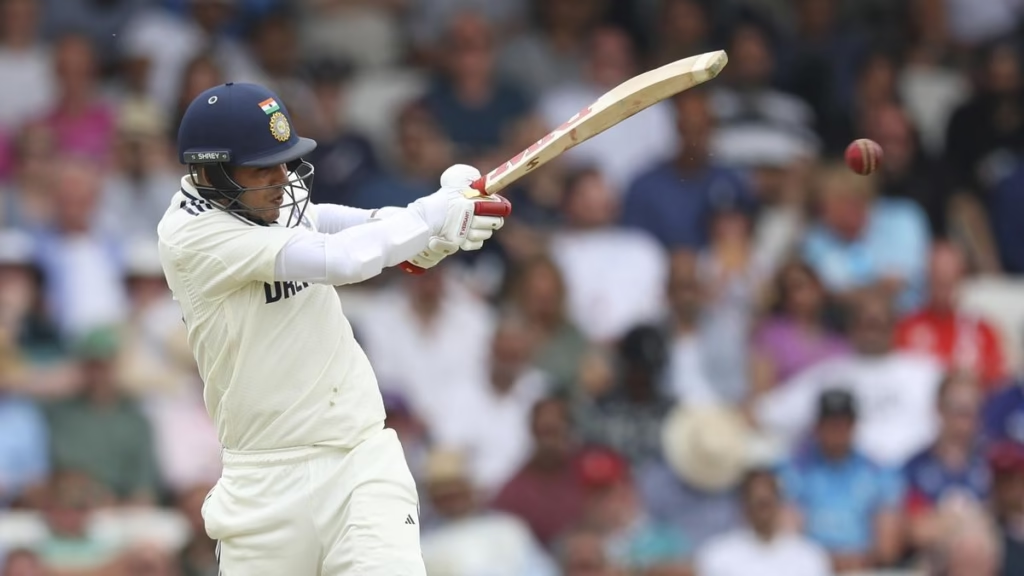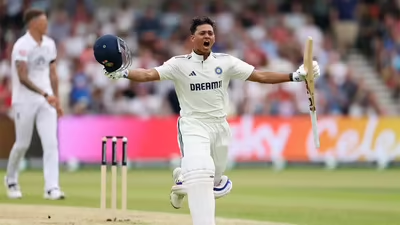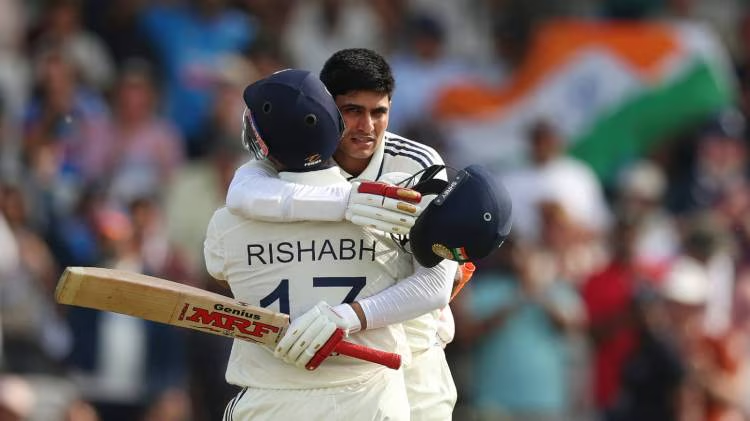As India’s young leaders roar in Leeds, the real challenge begins—can they sustain momentum through England and seize the WTC crown?
THE NEW MAHARAJAS? India’s Young Lions Roar in Leeds—But Can Gill’s Cubs Rule the Empire Beyond expectations
By Abhimanyu Ghosh, CEO and Group Editorial Director, WCRC
- As India’s young leaders roar in Leeds, the real challenge begins—can they sustain momentum through England and seize the WTC crown?
- The Weight of the Crown
- The Fighter Beside the Prince
- The Pitch, the Absentees, the Asterisk
- Enter Gambhir: Architect or Alchemist?
- The Road Ahead: Ordeal or Opportunity?
- The Verdict (for Now): Not a Coronation, But a Curtain Raiser
The image is indelible: Shubman Gill, helmet raised, eyes glinting under the Headingley sun, bat outstretched like a scepter. Behind him, Yashasvi Jaiswal, sweat-soaked and battle-weary, having carved his name into another foreign scorebook. Together, they scripted a blistering 359/3 on Day 1 of the first Test against England—Gill with a captaincy debut century; Jaiswal with history’s first triple-century tour initiation: hundreds in Australia, the West Indies, and now, England.
A glorious new dawn? Perhaps. Or is it just the golden hour before another long, dark English Test summer?

The Weight of the Crown
At just 25, Shubman Gill now holds the distinction of being India’s youngest-ever Test captain. The appointment, logical as it was, came wrapped in thorns. He steps in not only post-Rohit Sharma and Virat Kohli, but also after the retirement of cricketing craftsman Ravichandran Ashwin. This isn’t merely a captaincy; it’s an inheritance of legacy—and expectation.
Critics weren’t subtle. Gill’s Test average hovered around 35. His record outside Asia was modest. His appointment leapfrogged Jasprit Bumrah, India’s tactical general and previous series savior. But at Headingley, Gill didn’t flinch. Instead, he thrived—an authoritative 127* studded with elegance and restraint. No impulsive hooks. No reckless flashes. Just chessboard mastery of timing and tempo.
He became only the fifth Indian captain—after Gavaskar, Hazare, Vengsarkar and Kohli—to register a century in his debut innings at the helm. A new monarch? The first signs are promising.

The Delicious Dilemma of Raised Expectations
Yesterday’s heroics weren’t just a strong start; they were a seismic shift in narrative. A nation braced for a painful transition, potentially amplified by English conditions and the ghosts of past collapses, instead witnessed its young captain and prodigy author a historic opening statement. Shubman Gill’s serene authority and Yashasvi Jaiswal’s pain-etched century didn’t just fill the scoreboard; they filled a vacuum of belief. The initial dread of a potential “drubbing” has evaporated, replaced by a giddy, almost disorienting, question: Could they actually win this? The sheer weight of that 359/3 has irrevocably altered the emotional calculus of this series. What was once hoped-for resilience is now demanded dominance. The burden of proof has shifted dramatically onto Gill’s fledgling reign – not just to compete, but to convert this blazing dawn into tangible, series-altering victories. Two Test wins in England, once a distant dream for this raw squad, now feels not just possible, but the minimum benchmark for this start to be deemed truly era-defining rather than a glorious false alarm.
The Pitch’s True Test Awaits India’s Spearhead
Yet, the euphoria carries a caveat as stark as a Leeds grey sky: dominance on Day 1 guarantees nothing. The docile nature of the Headingley surface, a generous host to India’s batsmen, remains an unproven theory until Jasprit Bumrah unleashes his unique brand of high-velocity interrogation. Can this much-vaunted attack, brimming with promise but lacking the collective scars of Anderson or Broad in these conditions, exploit even this surface with the ruthless efficiency required to bowl England out twice? The answer lies not just in Bumrah’s magic, but in whether Siraj can sustain menace, if Jadeja can outfox Bazball’s bravado, and if the support cast can apply unrelenting pressure. When Stokes, Root, and Brook stride out, the benign deck of Day 1 will face its ultimate examination. India’s bowlers hold the scalpel; their performance will dissect the true nature of the pitch and reveal whether this batting bonanza was a fleeting gift or a foundation upon which a series can be won. Victory isn’t built on 359/3; it’s forged by taking 20 wickets, twice over. Until Bumrah’s roar echoes and English wickets tumble, the question lingers: Was this a new era’s declaration, or merely a spectacular prelude?
The Fighter Beside the Prince

If Gill ruled with grace, Jaiswal reigned through grit.
England came for him—bodyline style. Short balls, close catchers, and psychological pressure. Then came the cramps. Midway through his innings, Jaiswal was visibly hobbling. Physiotherapists ran out more often than drinks. Yet he endured.
After an awkward first hour dominated by leg-side traps and a stubborn 71% control rate, he pivoted his game—literally. The southpaw began slashing spin from deep inside his crease, upper-cutting quicks, and lofting deliveries over cover. The result? An unforgettable 101, scored with just 10 runs on the leg-side. A testament to adaptability. To problem-solving. To will.
“He’s got the hunger,” said former coach Rahul Dravid. “And more importantly, the mind.”
The Pitch, the Absentees, the Asterisk
Yet amid the fireworks, comes the question mark: Was this real resistance, or just an illusion created by perfect conditions?
Headingley’s pitch was docile—more tea garden than battlefield. England’s bowling? Toothless. No James Anderson, no Mark Wood, no Jofra Archer. Instead, an overburdened Ben Stokes, the reliable but gentle Chris Woakes, and greenhorns like Josh Tongue and Brydon Carse. This wasn’t an acid test. It was more like a net session gone public.
The signs of vulnerability were there. Sai Sudharsan, the debutant heir to Pujara’s No. 3 throne, lasted four balls. KL Rahul got a start, then fizzled. Apart from Pant’s electric 65 not out*, the middle-order remains a fortress untested.
Enter Gambhir: Architect or Alchemist?
Hovering quietly is Gautam Gambhir, newly installed as head coach. His fingerprints aren’t yet visible—but the philosophy is. Gill hinted pre-series at a bolder, braver India. Willing to play four tailenders. Willing to gamble.
Gambhir’s own career was built on bloody-nosed resistance. His influence, particularly against England’s Bazball blitz, may decide if this squad becomes history’s footnote or its headline.
The Road Ahead: Ordeal or Opportunity?
The shadows behind Gill are vast. Kohli’s charisma, Rohit’s calm, Ashwin’s cunning—they don’t vanish overnight. Gill’s tribe is talented, yes. But are they tested?
The coming days will tell. Lord’s will swing. Old Trafford will bounce. England will retaliate, likely at full strength. The English press will bay. And the WTC points tally will loom.
Can Bumrah and Siraj repeat their 2021 heroics? Can the lower order—so often the Achilles’ heel—stand strong? Can Gill’s calm outlast the storm?
The Verdict (for Now): Not a Coronation, But a Curtain Raiser
June 20 wasn’t a final exam. It was a rehearsal. But what a performance it was. India’s young lions roared—not with reckless abandon, but calculated bite.
They showed skill. They showed steel. Most importantly, they showed the one thing India desperately needs after the Kohli-Rohit-Ashwin exodus: hope.
But can hope win Test matches in Leeds, Manchester, and beyond? Can it weather the English summer’s swings and the weight of legacy?
Time, as always, will tell.










